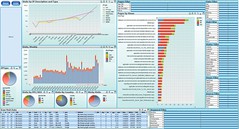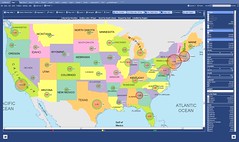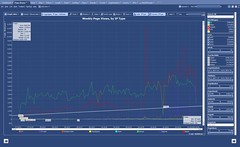As I said on this blog in many places, intelligence can not be an attribute of software (even if you called it Business Intelligence Software) – it is always a human attribute. Therefor BI leaders (who are desperately trying to convince their clients and customers that their software is competitive DV-wise) trying to mislead us to a non-existing place: BI paradise or BI heaven or whatever their BI platform is. It is why I called this page “DV Misleaders” – they mislead us to wrong place and I list/rank them below in order of their BI marketshare:
- SAP entered the BI market through its $6.8 billion acquisition of Business Objects, which closed in early 2008. Through the acquisition, SAP became the leading BI vendor by revenue. SAP Business Objects 4.0 and BW provide a full portfolio of BI functionality for enterprises while the SAP Business Objects Edge portfolio is geared toward SMBs. Recently SAP bought Sybase and as result it has a very large and broad portfolio of BI-related products. Like Oracle, SAP leverages its position in ERP in going to market with its BI platform.
- IBM entered the BI market with its $5 billion acquisition of Cognos in 2008, SPSS in 2009 and Netezza in 2010. IBM Cognos 10 is the company’s BI platform for enterprises which provides a comprehensive range of functionality for analysis and reporting, including the ability to create dashboards and scorecards to measure achievements versustargets. For mid-sized organizations, IBM offers the IBM Cognos Express product line including IBM Cognos Express Reporter, Advisor, and Xcelerator, providing reporting and ad hoc querying, analysis and visualization, and Excel-based analysis functionality, respectively. In addition, IBM acquired SPSS in2009 for $1.2 billion, adding predictive analytics, data mining, and statistical tools to IBM’s BI capabilities.
- SAS Institute holds the third-largest share in the BI market. SAS is a pure-play BI vendor with a full range of BI solutions though it is considered a leader in predictive data mining and advanced analytics. In addition to SAS 9.2, like the other large BI players in the market, SAS provides a BI offering for SMBs with functionality for data access, reporting, and analytics.
- Oracle offers an extensive BI platform largely consisting of BI tools from Oracle’s 2005 acquisition of Siebel ($5.9 billion) and 2007 acquisition of Hyperion ($3.3 billion). Oracle Business Intelligence Enterprise Edition (OBIEE 11g) is a comprehensive BI platform providing a full range of analytic and reporting capabilities. Beyond OBIEE, Oracle provides OBI Standard Edition One for smaller deployments (5-50 users), BI Publisher for reporting, and Essbase for OLAP (online analytical processing), among other tools.
- Microsoft offers
 lower-priced BI tools for reporting and analysis embedded within Microsoft Office, SharePoint, and Windows Server. Like many of Microsoft’s corporate products, the company’s BI tools have historically been geared toward SMBs. In addition, the recent release of SQL Server’s PowerPivot added an in-memory database tool for ad hoc querying and analysis.PowerPivot is used within Excel and integrates with SharePoint. When compared to the smaller pure-play BI vendors (e.g., QlikTech, TIBCO Spotfire, Tableau), Microsoft’s PowerPivot does not currently offer an equivalent range of visualization and interactivity functionality. PowerPivot lacks functionality when compared to other pure plays is interactive analysis. PowerPivot only allows for the application developer to drilldown into data in an interactive fashion while clients or end users are not able to do the same. This makes Microsoft’s tool better suited for individual analysis versus group or departmental analysis and creates a larger competitive advantage for the smaller pure-play vendors. Given the recent availability of this solution to the market, and Microsoft’s ubiquity in the enterprise and smallbusiness, the adoption of this product is worth watching.
lower-priced BI tools for reporting and analysis embedded within Microsoft Office, SharePoint, and Windows Server. Like many of Microsoft’s corporate products, the company’s BI tools have historically been geared toward SMBs. In addition, the recent release of SQL Server’s PowerPivot added an in-memory database tool for ad hoc querying and analysis.PowerPivot is used within Excel and integrates with SharePoint. When compared to the smaller pure-play BI vendors (e.g., QlikTech, TIBCO Spotfire, Tableau), Microsoft’s PowerPivot does not currently offer an equivalent range of visualization and interactivity functionality. PowerPivot lacks functionality when compared to other pure plays is interactive analysis. PowerPivot only allows for the application developer to drilldown into data in an interactive fashion while clients or end users are not able to do the same. This makes Microsoft’s tool better suited for individual analysis versus group or departmental analysis and creates a larger competitive advantage for the smaller pure-play vendors. Given the recent availability of this solution to the market, and Microsoft’s ubiquity in the enterprise and smallbusiness, the adoption of this product is worth watching. - MicroStrategy is the sixth-largest vendor in the BI market and specializes in large deployments running on top of enterprise data warehouses. The company’s most recent suite, MicroStrategy 9.3 provides a full range of BI functionality including OLAP functionality, reporting, and dashboards. MicroStrategy is often considered a higher-end BI vendor.
Gartner analysts have found that only 28% of employees who have access to old school BI reports actually use them. In addition to above I obliged to mention some other companies here: they are not misleaders, but they are in the picture:
• Traditional BI and data warehouse companies (Information Builders and Teradata still independent, Netezza now is part of IBM) recently was joint by EMC who is trying to get into BI market when it bought Greenplum.
• Smaller competitors in many cases are not are misleaders, they just small but sometimes they have very exciting DV Products (e.g. Omniscope, SpreadsheetWEB) which make them attractive for large buyers. In addition to the larger competitors above, many smaller competitors are beginning to gain traction in the marketplace (e.g., Actuate, Panorama, Visokio, Visual Mining, Panopticon, Pentaho, Jaspersoft, Advizor Solutions, Board, arcplan, Pagos, IDV Solutions etc.) due a huge growth in Data Visualization and “BI” market.
Permalink: https://apandre.wordpress.com/tools/dv-misleaders











Leave a comment